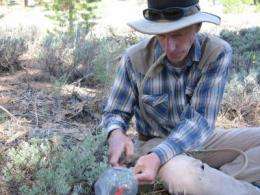Plant communication: Sagebrush engage in self-recognition and warn of danger

"To thine own self be true" may take on a new meaning—not with people or animal behavior but with plant behavior.
Plants engage in self-recognition and can communicate danger to their "clones" or genetically identical cuttings planted nearby, says professor Richard Karban of the Department of Entomology, University of California, Davis, in groundbreaking research published in the current edition of Ecology Letters.
Karban and fellow scientist Kaori Shiojiri of the Center for Ecological Research, Kyoto University, Japan, found that sagebrush responded to cues of self and non-self without physical contact.
The sagebrush communicated and cooperated with other branches of themselves to avoid being eaten by grasshoppers, Karban said. Although the research is in its early stages, the scientists suspect that the plants warn their own kind of impending danger by emitting volatile cues. This may involve secreting chemicals that deter herbivores or make the plant less profitable for herbivores to eat, he said.
What this research means is that plants are "capable of more sophisticated behavior than we imagined," said Karban, who researches the interactions between herbivores (plant-eating organisms) and their host plants.
"Plants are capable of responding to complex cues that involve multiple stimuli," Karban said. "Plants not only respond to reliable cues in their environments but also produce cues that communicate with other plants and with other organisms, such as pollinators, seed disperses, herbivores and enemies of those herbivores."
In their UC Davis study, Karban and Shiojiri examined the relationships between the volatile profiles of clipped plants and herbivore damage They found that plants within 60 centimeters of an experimentally clipped neighbor in the field experienced less leaf damage over the season, compared with plants near an unclipped neighbor. Plants with root contact between neighbors, but not air contact, failed to show this response.
"We explored self-recognition in the context of plant resistance to herbivory ," he said. "Previously we found that sagebrush (Artemisa tridentata) became more resistant to herbivores after exposure to volatile cues from experimentally damaged neighbors."
The ecologists wrote that "naturally occurring herbivores caused similar responses as experimental clipping with scissors and active cues were released for up to three days following clipping. Choice and no-choice experiments indicated that herbivores responded to changes in plant characteristics and were not being repelled directly by airborne cues released by clipped individuals."
In earlier research, Karban found that "volatile cues are required for communication among branches within an individual sagebrush plant. This observation suggests that communication between individuals may be a by-product of a volatile communication system that allows plants to integrate their own systemic physiological processes."
The scientists made cuttings from 30 sagebrush plants at the UC Sagehen Creek Natural Reserve and then grew the cutting in plastic pots. They grew the cuttings at UC Davis and then placed the pots near the parent plant or near another different assay plant (control group) in the field.
Source: University of California - Davis
















